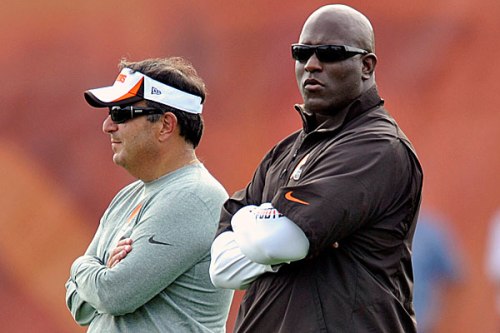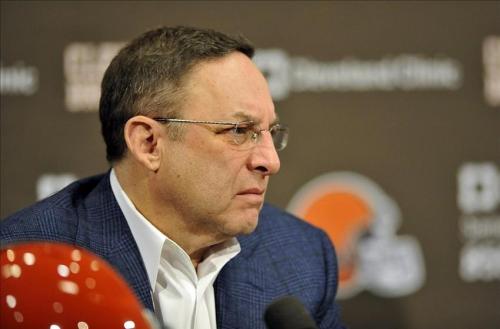By Adam Bennett, @HFSCleveland
Any Browns fan knows the organization has been one of the worst, if not THE worst, when it comes to executing on the field. Most fans also know the team is one of the worst when it comes to executing in the draft.The widespread perception is the Browns are being held back on the field because the organization’s various general managers and personnel people are performing poorly off the field. Today, we provide some light to that perception with statistics.

Former Browns GM Mike Lombardi and current Browns GM Ray Farmer watch a 2013 Browns practice in Berea. (Photo via SI)
First, let’s take a look at the overall numbers. Between the four AFC North teams, the Browns trail by a wide margin when it comes to players on the current roster that were drafted by their original team since 2010.
PERCENTAGE OF PLAYERS DRAFTED BY A TEAM STILL PLAYING FOR THAT TEAM (SINCE 2010)
- Cincinnati – 56 percent
- Pittsburgh – 50 percent
- Baltimore – 47 percent
- Cleveland – 33 percent
The Bengals have statistically been the best drafting team in the division over the last five years, which is a staggering statistic seeing that their owner, Mike Brown, is the one with final say on draft picks. That being said, he’s beating everyone else. Cincinnati has groomed their own hand-selected talent well under head coach Marvin Lewis, and the result is three straight playoff appearances.
As we dive into the numbers further, the Bengals’ success also shows the importance of keeping the players you draft as they reach the prime of their careers – which typically occurs four to five years following their coming out of college. In the three drafts from 2010-2012, the Bengals again lead the division in players retained:
- Cincinnati – 40 percent
- Pittsburgh – 36 percent
- Baltimore – 26 percent
- Cleveland – 13 percent
Cleveland, at the bottom of the list, has only retained 13 percent of the players it drafted from 2010-2012. That is the lowest percentage in the NFL.
More important, however, may be the drastic differences in teams keeping their high-end talent, compared to keeping or releasing players drafted in rounds 4-7.
PLAYERS DRAFTED 1-3 STILL PLAYING FOR THEIR DRAFTING TEAM (SINCE 2010)
- Pittsburgh – 80 percent
- Cincinnati – 74 percent
- Baltimore – 69 percent
- Cleveland – 42 percent
Easily the most depressing stat for the Browns is that they’re a full 27 percentage points lower than the next worst team in the division when it comes to retaining talent that they’ve made a significant investment in at the high end of the draft.
Furthermore, that number doesn’t even highlight what kind of impact those players are making on the field. For example, the Browns’ 42 percent includes players like Justin Gilbert (who’s not even on the top 5 of the depth chart at his position), John Hughes (who’s still a backup), Barkevious Mingo (who seems to be injured more than he plays), and Johnny Manziel, who couldn’t so far win the QB job over Brian Hoyer and Josh McCown, two journeymen veterans. In fact, the only player the Browns have drafted high in this 5-year span that’s making a significant impact is Joe Haden, who was selected by Tom Heckert in 2010.
The whiffs at the top of the draft are only part of a bigger problem for the Browns, who are the only team in the division not retaining nearly 3/4 of the talent they selected from 2013-2014:
- Baltimore – 80 percent
- Cincinnati – 79 percent
- Pittsburgh – 73 percent
- Cleveland – 62 percent
Admittedly, 2013 really hurts the Browns in this particular category, as Joe Banner and Mike Lombardi only made five selections. Of those five selections, only two remain on the team (Mingo and Armonty Bryant) while one is out of the league (Jamoris Slaughter) and two are playing elsewhere in the NFL (Leon McFadden, Garrett Gilkey).
Also to be noted, in the five year span that we looked at, the Browns had three different general managers (Tom Heckert, Joe Banner/Mike Lombardi, Ray Farmer). The Bengals, Ravens and Steelers each had the same GM – or owner, in Cincinnati’s case – making picks for them.
When it comes to finding actual talent, the Browns haven’t been as bad as you may think. Consider the fact that since 2010, 72 percent of the players the team selected are still playing in the NFL. The issue is, of course, just 33 percent are still playing for the Browns. That speaks to the larger issue of extreme turnover on the coaching staff and in the front office, as different GMs and different coaches want a different style of players. The Browns have had four coaches in the five year drafting span we evaluated.
Of course, not highlighted in these statistics is the fact that a good quarterback can hide most of these problems for teams. Consider the fact that Baltimore has only retained 29 percent of the talent they selected from 2010-2012. Those players, theoretically, would be in the prime of their careers now. So the Ravens have struggled in that regard. But they have a good quarterback and a good coach, and those problems haven’t translated to the field as much as they have for a team like the Browns.
The bottom line is twofold: First, the extreme turnover on the Browns’ coaching staff and in the front office has significantly impacted their ability to both select and keep good players, and secondly, until the team finds a quarterback, no matter how well they draft they won’t be able to take the next step.





The amount of coaching turnover is equally proportionate to the amount of turnover on the roster.
LikeLike
Pingback: Phoenix Area Browns Backers | The Cleveland Browns’ eternal cluelessness: Bill Livingston (photos)
Pingback: For The Browns, Continuity Is No Excuse To Keep Decision Makers | HARD FOUL SPORTS